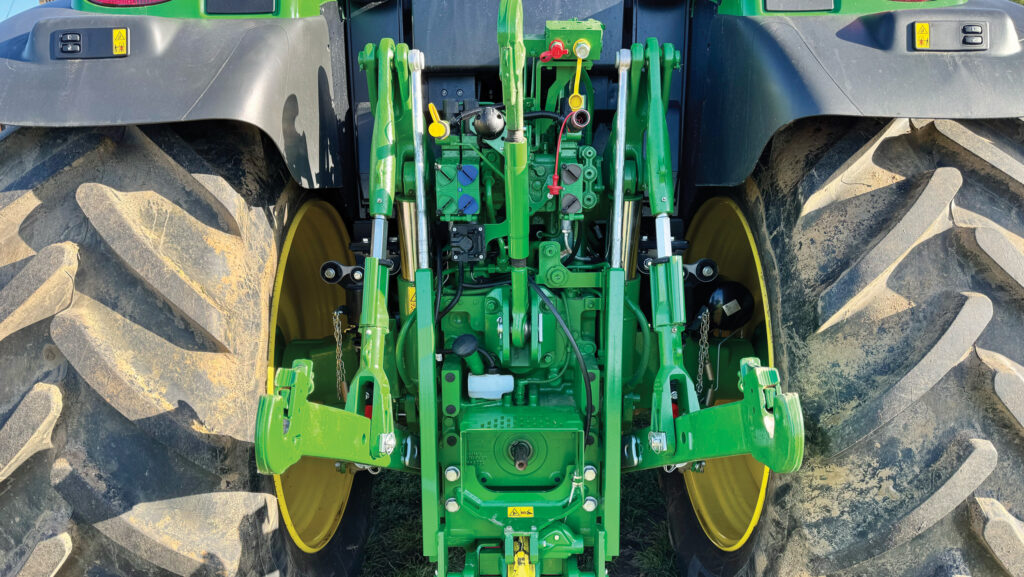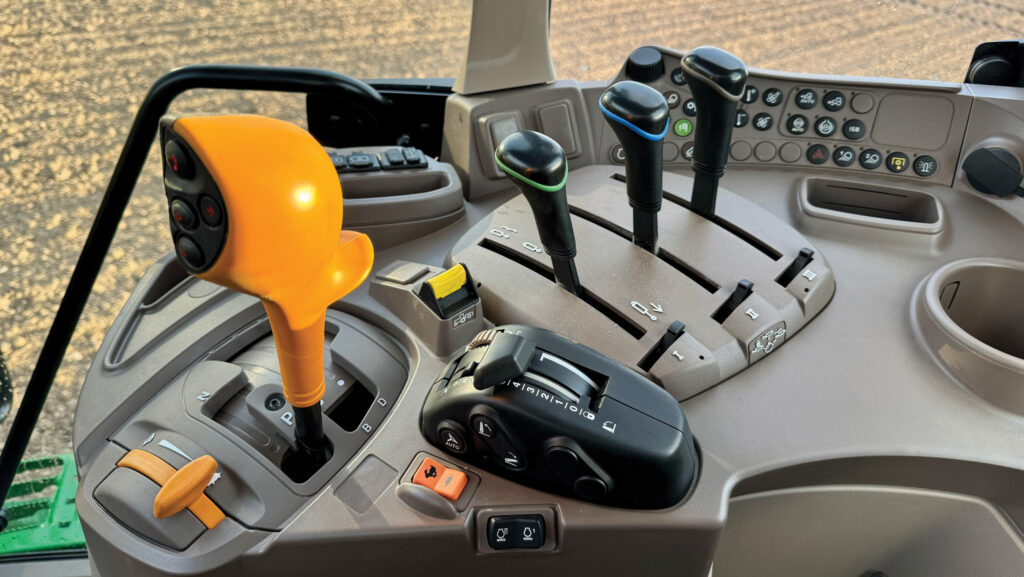On test: Time-proven John Deere 6M 155 finally gets 50kph
 © MAG/Oliver Mark
© MAG/Oliver Mark Some tractors prove to be stinkers, others functional if unremarkable, and a very select few transcend an era.
John Deere’s 30-series – the 6930 and 7530 in particular – has done just that, with some enthusiasts practically remortgaging to buy a machine built almost 20 years ago.
See also: On test: Fendt’s four-cylinder, 224hp 620 – small engine, big power
Understandably keen to milk that recipe for all it’s worth, last year Deere added to the 6930’s storied bloodline with a mildly titivated 6M 155 that aims to tempt said folk into buying new rather than old.
The standouts on a relatively short list of updates were the addition of an A-pillar display and, for the first time, a 50kph top speed – something contractors have been screaming for.
Deere also took the opportunity to fluff out the 6M family, such that it now contains a faintly ridiculous 17 different models from the 120hp 6M 95 to the 281hp 6M 250.
This scattergun approach guarantees that there is a green-and-yellow tractor to suit everyone. And, in theory at least, one that can be priced to compete with those from New Holland and Massey Ferguson.
They’re designed to be the perfect foil for the premium R-series and, as such, come with a ruthlessly basic spec as standard, to which buyers can add the extras they need without also getting the things they don’t.
However, landing potential savings relies on monk-like discipline when faced with the options list. Get trigger happy and the £25k price difference between 6M 155 and 6R 155 will rapidly evaporate.
John Deere 6M 155 AutoQuad
- Engine 6.8-litre, six-cylinder Deere
- Max/boosted power 171/182hp
- Max torque 726Nm
- Transmission Five-range, four-speed semi-powershift
- Top speed 50kph
- Lift capacity 7.6t rear; 3.9t front
- Wheelbase 2,765mm
- Turning circle 11.2m on 540/65 R28 front tyres
- Weight 7.8t
- List price £128,000
More speed
Most critical of the 6M updates unveiled last summer was a higher top speed, having been hitherto hobbled by a 40kph limit.
With 50kph a non-negotiable for so many, especially contractors keen on an otherwise lean spec for tractors devoted to silage carting, slurry tanking and umbilical pumping, this will make all the difference – and match that of the 6Rs (60kph pending, perhaps?).
For most, the AutoQuad transmission will suffice. It needs little introduction, with Deere having sold squillions of them during their 30-odd years in service.
In that time, they’ve established a reputation for being efficient, reliable and dead simple.

© MAG/Oliver Mark
As ever, it comes with a long and satisfyingly clunky lever for the five ranges, flanked with buttons for the four powershift steps.
These are snappier than equivalents from most rival manufacturers; decent speed matching allowing them to drift from one to the next with molten ease.
Opting for this transmission also has appeal further down the line, as the tractors will hold their value better than the slightly more troublesome AutoPowr CVTs (+£10,000).
There’s also a CommandQuad version (+£3,000), which packs the same 20×20 setup as the AutoQuad with the benefits of robotised range changes and the useful but not essential “auto clutch” to stop solely using the brakes.
This, and the billy basic PowrQuad – which is only £900 cheaper than AutoQuad and thus barely worth considering – are both restricted to 40kph on the 6M 155, so won’t sell in any numbers.
Power boost
Like the transmission, Deere’s 6.8-litre engine seems to have been knocking around forever.
But it has gained a boost function (IPM in JD parlance) for the first time on 6Ms. Good though it is, in some ways it feels the company has both giveth and taketh away.
The extra 11hp on jobs involving power-sapping pto, hydraulic or transport work is welcome. However, this is 21hp less than that of the 6R.
So, while they both have a pre-boost maximum of 171hp, the M hits a 182hp ceiling while the R can rev its way to 203hp – despite there being no difference in the hardware involved.
No doubt some laptop-wielding software technicians will be primed with a cure…
Performance is otherwise fine, if a little flat; the snappiness of powershifts can often save the day when the crankshaft slows to a seemingly irretrievable speed.
Back to basics
Further parts bin plundering in the cab department, with the six-post frame harking back to 6020-series days.
It’s a Marmite affair: Luddities will be cock-a-hoop with the austerity of it all, more progressive types certainly not. Space is the biggest concession, at 2.7cu m well down on the 6R’s 3.3cu m penthouse.
Despite this sizeable difference in volume, those yet to acquaint themselves with R-series’ opulent office space won’t be upset, as it’s still bright, airy and compares well with that of a New Holland T7 SWB.
The rudimentary furnishings also belie impressive sound deadening.
Sole improvement of note is the addition of a corner post display, as used on Waterloo-built 7-, 8- and 9-series tractors.

© MAG/Oliver Mark
Controlled by a suitably old-school dial and buttons on the side console, it’s no match for an armrest-mounted G4 or G5 terminal but serves a surprising number of purposes.
Among them, rear linkage and pto settings, engine droop and cruise speeds, shuttle aggressivity, work light setup and air conditioning adjustments – all easy to find, with few layers to navigate.
Most of the other cab internals have been rolled over from previous generations.
This includes the “quadrant” depth control slider – albeit with flat buttons that can be harder to blindly locate than the old concave/convex arrangement – and the ubiquitous return-to-centre shuttle.
There’s also a plastic phone-sized pocket complete with a USB and twin USB-C charging ports on the side console.
Any other differences with the 6R?
As mentioned, the essence of the 6M tractors is that buyers can tailor the spec to their liking without wasting money on seldom used features.
According to Deere, the most common upgrades are a bigger hydraulic pump, upping output from 114 litres/min to match the 155 litres of the Rs (£907), mechanical cab suspension (£1,275) and a premium seat (£1,977). Clearly some luxuries are sacrosanct.
Lift is also a little lower – 7.6t versus 8.1t – and there’s a limit of four rear spools, down on the R’s six.
Given the assumed demographic of M-series customers, these will be taken with basic mechanical levers, though Deere will willingly waft the sweet scent of temptation under the nose of interested parties.
No doubt some will nibble on the offer of electric paddles.

© MAG/Oliver Mark
One thing that isn’t on the agenda is the firm’s premium CommandArm that litters all the controls, some configurable, on a supersized armrest – a setup diehard R-series drivers would be loath to sacrifice.
And, to avoid Ms cannibalising Rs on arable farms, nor can it be armed with all the firm’s precision ag stuff, such as Machine Sync that allows the combine operator to take control of the tractor during unloads.
The Ms are, in some ways, a paradox. Easier to drive for those that have mastered the art – but without all the high-tech cheat codes that make life so breezy for operators willing to invest the time to exploit them.
Farmers Weekly verdict
Depending on your view, 6M tractors are either a sensible way of getting yellow wheels and a green bonnet, or too primitive to be gracing the Deere portfolio.
Though both are fair, the bonkers prices for noughties-built 6930s suggests there are plenty in the former camp.
And, bar the unavoidable addition of an AdBlue system, EGR valve and DPF, all of which come with strings attached, they’re unlikely to be disappointed.

© MAG/Oliver Mark
But it might be a different story for those trading down from an R-series. There may be little to split the two ranges engineering wise, but few drivers will take kindly to the prospect of relinquishing so many mod-cons.
As it stands, the 6R 155 continues to outsell the M, but with low wheat prices, inheritance tax and general industry melancholy continuing to bite – and farm expenditure under the microscope like never before – that could soon change.
Likes and gripes
Likes
- Time-proven transmission – now with 50kph
- Simple to operate
- Quiet in the cab
- Loads of spec options
Gripes
- Depth control “quadrant” misses concave/convex buttons
- Six-post cab will be too small and basic for some
- Price can quickly creep into R-series territory
The range
John Deere’s 6M-series relaunch centred on the introduction of seven new variants, taking the total range to a mind-boggling 17 strung across five chassis sizes.
Spare a thought for hard-pushed dealers having to recall the spec of each.
Predictably, the most powerful in each group is also the most popular, none more so than the 6M 125 that outsells its “short frame” siblings, the 95, 105 and 115, combined.
Above these are a further three four-cylinder models – the “small frame” 130, 140 and 150 – followed by the six-cylinder “mid frames” encompassing the 145, 155, 165 and 185.
Most of the new additions are in the higher reaches of the range, which now includes the “large frame” 180, 200, 220 and 240, followed by the “extra large” 230 and 250.

